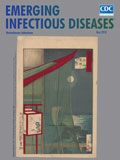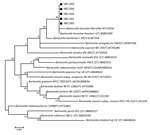
Volume 24, Number 5—May 2018
Dispatch
Characterization of Clinical Isolates of Bartonella henselae Strains, South Korea
On This Page
Article Metrics
Altmetric:
Citations: 0
Views: 44Views equals page views plus PDF downloads
Metric DetailsHea Yoon Kwon1, Young Kyoung Park1, Sun Myoung Lee, Ji Hyeon Baek, Jae-Seung Kang, Moon-Hyun Chung, Eun Ji Kim, and Jin-Soo Lee
Abstract
Bartonella henselae, a gram-negative bacterium, is a common causative agent of zoonotic infections. We report 5 culture-proven cases of B. henselaeinfection in South Korea. By alignment of the 16S rRNA sequences and multilocus sequencing typing analysis, we identified all isolates as B. henselaeHouston-1 strain, which belongs to sequence type 1.
The genus Bartonella includes infectious, gram-negative, facultative intracellular bacteria of numerous species. Among the Bartonella species, B. henselaeis known as one of the most noteworthy pathogens (1). B. henselae causes cat-scratch disease, which is a common zoonosis and manifests various clinical symptoms (2).
A case of B. henselae infection in South Korea was confirmed in 2005 by PCR (3). Although a few more studies have been published after this case of B. henselae, only 2 cases were culture-proven: 1 from blood and 1 from bone marrow (4,5). Because of difficulties in cultivation and isolation, studies of the isolation of B. henselae from clinical specimens remain scarce. In this study, we analyzed the characteristics of the isolated B. henselae strains in South Korea and compared the clinical features of the patients.
We conducted the study among patients who visited Inha University Hospital, a tertiary hospital in Incheon, South Korea, during 2009–2016. From these patients, we isolated 5 cases in which B. henselae was identified from cultures of blood or bone marrow (Table 1).
Case-patient 1 (IIBC1301) was a 22-year-old man hospitalized for left inguinal lymphadenopathy that had started 10 days earlier. His body temperature was 38.5°C, and he had rashes that started on the palms and soles and subsequently spread to his entire body. B. henselae was isolated from the blood that was cultured on the second day of hospitalization.
Case-patient 2 (IIBC1302) was a 40-year-old woman hospitalized for fever and myalgia, symptoms that had lasted for 1 month. The patient had an erythematous papular rash on her face and extremities and tenderness in her abdomen. Computed tomography (CT) of the abdomen showed chronic cholecystitis; therefore, levofloxacin and metronidazole were prescribed (Technical Appendix[PDF - 253 KB - 1 page] Figure, panel A). B. henselae was identified from cultures of blood obtained on the first day of the hospitalization. The patient had not raised any animals. After discharge, the patient experienced continuous fever, poor oral intake, and weight loss. Reevaluation showed centrilobular ground-glass opacity in both lung fields on chest CT and growth of Mycobacterium tuberculosis on sputum acid-fast bacilli culture (Technical Appendix[PDF - 253 KB - 1 page] Figure, panel B). A pulmonary tuberculosis infection was diagnosed and treated with antituberculosis medication.
Case-patient 3 (IIBC1303) was a 52-year-old woman hospitalized for fever and left flank pain; her symptoms had persisted for 1 month. She also reported right-side neck swelling and pain at neck levels II, III, and VA. B. henselae was isolated from cultures of blood collected on the 16th day of hospitalization. She had no contact with animals.
Case-patient 4 (IIBC1304) was a 42-year-old man we previously reported (5) whose main complaints were fever, rash, and arthralgia. B. henselae was isolated from a bone marrow sample. The patient had no contact with or experience in raising pets.
Case-patient 5 (IIBC1305), also previously published (4), was a 73-year-old woman who had B. henselae isolated from her blood. She also did not have any contact with animals.
Bartonella species can be grown by blood agar–based culture systems. However, it is difficult to culture them this way because the growth of bacterial cells is slow, and obtaining colonies on the agar plate takes a long time. On the other hand, Bartonella species grow more rapidly with cell culture–based systems (6). For testing of these patients, we grew ECV304 cells in M199 media containing 10% heat-inactivated fetal bovine serum and inoculated 1 mL of whole blood or other samples from the patients onto the cells. After 24 hours, we washed the cells with Dulbecco’s phosphate-buffered saline and maintained them in M199 media. We performed an immunofluorescence assay (IFA) with the patient’s own serum (1:40 diluted) every week after the inoculation. When the growth of bacteria was observed, we scraped all cultured cells from the T25 flask. We then reinoculated 1 mL of infected ECV304 cells onto uninfected ECV304 cells in a T75 flask for expansion of bacterial cells.

Figure. Phylogenetic tree of 5 Bartonella henselae clinical isolates from patients in South Korea (black dots) and closely related species based on 16S rRNA gene sequences. Database accession numbers are provided for...
To identify the bacterial isolates, we amplified and sequenced the 16S rRNA gene (7). The pathogens cultured from the specimens showed the highest sequence similarities with B. henselae Houston-1 strain (GenBank accession nos. KY773227, KY773228, KY773229, KY773290, and KY885188). The similarity was >99% (Figure) (8,9). IFA results using a commercial Bartonella IFA IgG kit (FOCUS Diagnostics, DiaSorin Molecular, Cypress, CA, USA) also showed positive results for all patients’ serum samples; titers ranged from 1:40 to 1:1,280 (Table 1). We also performed multilocus sequence typing to determine the genotypes of B. henselae isolates (10) and found that all isolates belonged to sequence type 1 (Table 2).
We cultured B. henselae isolates from clinical samples and compared characteristics of 5 patients: 3 new cases and 2 previously reported cases from which B. henselae was isolated (Table 2). Because of the diverse manifestations of B. henselae infection, the symptoms were similar to those of other bacterial infections. B. henselae infections in 3 patients were initially misdiagnosed as other diseases: sexually transmitted disease (case-patient 1), enteric fever-like syndrome (case-patient 2), and acute pyelonephritis (case-patient 3). The diagnosis of B. henselae infection was made even more difficult because none of these 5 patients reported a history of raising cats. However, the absence of contact with animals should not preclude infection; even though B. henselae infection is ususally related to cat scratches or bites, it may also occur without animal contacts (5). It is also noteworthy that the patient described in case 2 was co-infected with pulmonary tuberculosis. Co-infection with B. henselae and Mycoplasma spp. has also been reported in previous studies (11,12). Co-infection with other bacteria suggests that infection with Bartonella species may weaken the host’s immune system, leaving the host vulnerable to secondary infections. In addition, these co-infections may cause difficulty in diagnosing Bartonellainfection.
Multilocus sequence typing indicated that all isolates from this study belonged to B. henselae sequence type 1. This result is consistent with previous studies, which showed relatively less diversity among human strains than among the feline reservoir (10,13).
In summary, the clinical features of B. henselae infection are diverse and nonspecific, which could initially lead to misdiagnosis as other diseases. Physicians and patients should consider that Bartonella infection presents various clinical symptoms and might be a common cause of fever of unknown origin, irrespective of exposure to cats. Once Bartonella infection is suspected, cell culture should be considered to confirm the diagnosis.
Acknowledgment
This work was supported by a research grant from Inha University Hospital, Incheon, Korea.
References
- Maggi RG, Mozayeni BR, Pultorak EL, Hegarty BC, Bradley JM, Correa M, et al. Bartonella spp. bacteremia and rheumatic symptoms in patients from Lyme disease-endemic region. Emerg Infect Dis. 2012;18:783–91. DOIPubMed
- Nelson CA, Saha S, Mead PS. Cat-Scratch Disease in the United States, 2005-2013. Emerg Infect Dis. 2016;22:1741–6. DOIPubMed
- Chung JY, Han TH, Kim BN, Yoo YS, Lim SJ. Detection of bartonella henselae DNA by polymerase chain reaction in a patient with cat scratch disease: a case report. J Korean Med Sci. 2005;20:888–91. DOIPubMed
- Im JH, Baek JH, Lee HJ, Lee JS, Chung MH, Kim M, et al. First case of Bartonella henselae bacteremia in Korea. Infect Chemother. 2013;45:446–50. DOIPubMed
- Durey A, Kwon HY, Im JH, Lee SM, Baek J, Han SB, et al. Bartonella henselae infection presenting with a picture of adult-onset Still’s disease. Int J Infect Dis. 2016;46:61–3. DOIPubMed
- La Scola B, Raoult D. Culture of Bartonella quintana and Bartonella henselae from human samples: a 5-year experience (1993 to 1998). J Clin Microbiol. 1999;37:1899–905.PubMed
- Lane DJ. 16S/23S rRNA sequencing. In: Stackebrandt E, Goodfellow M, editors. Nucleic acid techniques in bacterial systematics. Chichester (UK): Wiley; 1991. p. 115–75.
- Tamura K, Nei M. Estimation of the number of nucleotide substitutions in the control region of mitochondrial DNA in humans and chimpanzees. Mol Biol Evol. 1993;10:512–26.PubMed
- Tamura K, Stecher G, Peterson D, Filipski A, Kumar S. MEGA6: Molecular Evolutionary Genetics Analysis version 6.0. Mol Biol Evol. 2013;30:2725–9. DOIPubMed
- Iredell J, Blanckenberg D, Arvand M, Grauling S, Feil EJ, Birtles RJ. Characterization of the natural population of Bartonella henselae by multilocus sequence typing. J Clin Microbiol. 2003;41:5071–9. DOIPubMed
- Sykes JE, Lindsay LL, Maggi RG, Breitschwerdt EB. Human coinfection with Bartonella henselae and two hemotropic mycoplasma variants resembling Mycoplasma ovis. J Clin Microbiol. 2010;48:3782–5. DOIPubMed
- dos Santos AP, dos Santos RP, Biondo AW, Dora JM, Goldani LZ, de Oliveira ST, et al. Hemoplasma infection in HIV-positive patient, Brazil. Emerg Infect Dis. 2008;14:1922–4. DOIPubMed
- Dillon B, Valenzuela J, Don R, Blanckenberg D, Wigney DI, Malik R, et al. Limited diversity among human isolates of Bartonella henselae. J Clin Microbiol. 2002;40:4691–9. DOIPubMed
Figure
Tables
Technical Appendix
Cite This ArticleOriginal Publication Date: 3/28/2018
1These authors contributed equally to this article.






















.png)











No hay comentarios:
Publicar un comentario